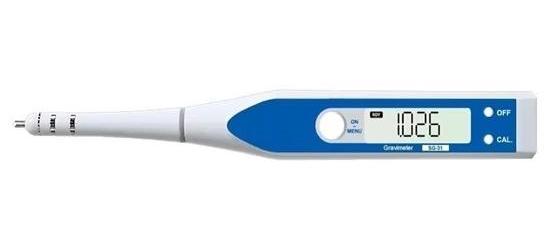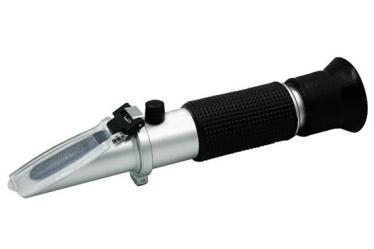Hydrometer vs Refractometer
Refractometers and gravimeters, both instruments for measuring liquid properties, have distinct functions and applications. Each instrument offers unique advantages that are suited to specific uses. The choice of instrument should be guided by the properties of the liquid under examination and the goals of the analysis. In some cases, the two can be used in conjunction to obtain a more comprehensive liquid characterization.
Hydrometer Basics
The Hydrometer is an instrument widely used in brewing, winemaking, and chemistry to measure the specific gravity, or density, of a liquid relative to water. The measurement is made by means of a calibrated glass tube with a weight at the bottom to keep it floating upright in the liquid. To use it, the hydrometer is placed in the liquid to be measured, allowed to float freely, and the scale value at the point of liquid surface contact is read to obtain the specific gravity of the liquid.
Hydrometers are indispensable tools in the brewing and winemaking process. By measuring the original specific gravity (OG) and final specific gravity (FG) before and after fermentation, it is possible to assess the sugar content and calculate the alcohol content (ABV). In chemistry, densimeters or refractometers are used to determine the concentration of different solutions. Also, in the automotive industry, hydrometers are used in battery testing to reflect the state of charge of a battery by measuring the specific gravity of the battery acid.

To use a hydrometer, you first need to fill a test bottle with the liquid to be measured, then place the hydrometer into the liquid, ensuring it does not touch the sides of the bottle and floats freely. The hydrometer should be gently rotated to dislodge any air bubbles, and the specific gravity is then read on the scale at the surface of the liquid.
The advantages of a hydrometer include high accuracy, cost-effectiveness, ease of use, and intuitive readings. However, it has some disadvantages, such as requiring larger sample sizes which can lead to wasted liquid; the glass material makes it fragile and requires careful handling; and it needs to be sterilized periodically to avoid contamination during the brewing process. Despite these drawbacks, the digital hydrometer remains the tool of choice for specific gravity measurement of liquids because of its efficiency and economy.
Refractometer Basics
A refractometer is a precision instrument used to measure the refractive index of a liquid, which is often directly related to the concentration of a dissolved substance such as sugar. It is particularly important in industries like brewing and winemaking, where monitoring sugar content is crucial. By measuring how much light is refracted in a liquid, refractometers can provide an accurate reading of the concentration, usually expressed as Brix or specific gravity. Refractometers come in various types, including handheld, digital, and laboratory models, to suit different usage environments and accuracy requirements. Handheld refractometers are compact and portable for quick field measurements; digital refractometers offer automatic temperature compensation and digital readout, ensuring measurements are unaffected by temperature variations; and laboratory refractometers provide higher accuracy, making them suitable for scientific research and quality control.

To use a refractometer, it is first calibrated with distilled water. Then, a sample of the liquid to be measured is added dropwise to the prism, and the refractive index is read through the eyepiece or digital display. This instrument is widely used to monitor the fermentation process in brewing and winemaking, determine the ripeness of fruits and vegetables in agriculture, and measure salinity levels in aquaculture.
Whether you need to select the right specific gravity meter for a particular application or need a high-precision refractometer to optimize product quality control, ATO Industrial Automation can provide you with expert guidance and support. The platform provides comprehensive technical articles, product information and industry solutions to help you better understand how these instruments work, why they were selected, and how they can be used in different industrial automation scenarios.
Key Differences
The primary distinction between a refractometer and a density meter is the method used to measure liquid density. Refractometers analyze the bending of light as it passes through the sample, requiring only a few drops of liquid. In contrast, density meters rely on a larger sample volume, which increases the risk of contamination. The instrument is highly efficient and suitable for frequent sampling, with minimal wastage and contamination risks. Conversely, the refractometer requires a larger sample volume, increasing the potential for contamination.
When to Use Each Tool?
Specific gravity meters are preferred when you need to determine the total amount of dissolved substances in a liquid or the relative density of a liquid. For example, in the brewing industry, specific gravity meters are used to measure the original and final specific gravity of wort or wine to assess sugar conversion and potential alcohol yield. In chemical analysis, specific gravity meters help determine the concentration or purity of a solution. In addition, specific gravity meters are used in battery maintenance to assess the state of charge of a battery by measuring the specific gravity of the electrolyte.
Refractometers, on the other hand, focus on measuring the refractive index of a liquid, which is often related to the concentration of a specific dissolved substance in the liquid, such as brix. When you need to accurately measure the concentration of a specific substance, a refractometer is a more appropriate choice. In the food industry, refractometers are used to determine the sugar content of products such as fruit juices and honey. In the pharmaceutical industry, it is used to ensure the exact concentration of drug solutions. In agriculture, a refractometer assesses the health of a crop by measuring the refractive index of plant sap to infer its sugar level.
Choosing a specific gravity meter or a refractometer depends on your specific needs and measurement goals. If the goal is to obtain information about the overall density of a liquid, a specific gravity meter is the more appropriate tool. And when the need is to analyze the concentration of a specific dissolved substance, the refractometer shows its unique advantages. Both are characterized by simple operation and accurate results, but the applicable scenarios are different.
In short, specific gravity meters and refractometers have their own unique applications and advantages. Understanding the working principle and application scenarios of each instrument will help you make the right choice of instrument when facing different measurement tasks, so as to obtain reliable and accurate measurement results.

